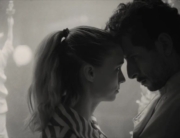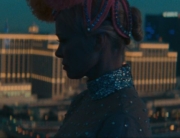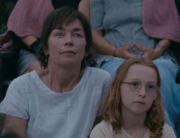
Alan Cumming holding court in ALMOST IN LOVE (Argot Pictures)
In his third independent feature film, Sam Neave’s introduces us to the romantic intrigues of close friends at two parties, 18 months apart. Shot with the structural conceit of two uninterrupted 40-minute takes, Daniel McKeown’s camera tracks a group of New Yorkers searching for love.
As the sun sets on a Staten Island roof terrace, writer Sasha (Alex Karpovsky) hosts a barbeque for his middle-class, 30-something friends. While the bohemian creatives candidly converse about sex, marriage, and relationships, a love triangle plays out. Sasha’s hopes of rekindling his friendship with ex-girlfriend Mia (Marjan Neshat) are frustrated by the arrival of his uninvited old friend and rival, Kyle (Gary Wilmes), from whom Mia has just split up. With a new girlfriend in tow, Kyle gets drunk and tension builds until Sasha is goaded into action.
Eighteen months later, the sun rises on the second party in a glamorous Hampton beach house for a wedding celebration that subverts our expectations. While bride and groom try to consummate their marriage in a bedroom upstairs, the same group of key friends pull a drunken all-nighter. The dynamic among them has changed with the introduction of new partners—like Hayden, played by Scottish actor Alan Cummings, who brings a welcomed momentum to the piece—and love in all its complications is still the preoccupation.
The rigor and technical difficulty of Daniel McKeown’s uninterrupted takes is ambitious, and his fluid, roaming camera is luscious but feels directionless at times, unable to overcome the theatricality of the production. The use of sound, though, is really interesting. Conversations drop in and out as characters move through the frame. The camera lingers on muted conversations while dialogue out of frame is overlaid. This device brings energy and intrigue, reinforcing the intimacy of the friendships and making one feel like a gatecrasher
While Almost in Love was scripted by Neave, he also encouraged the actors to improvise, but the characters still feel contrived. Variable performances are an inevitable consequence of the actors’ inability to anticipate the camera’s presence, but some come across as caricatures. All the characters are attractive, privileged, and creatively fulfilled individuals, and so it’s hard to believe and sympathize with any of their struggles to understand or hold onto love. For all the talk, the film falls flat with little insight to impart.






Leave A Comment